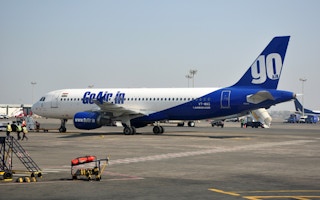When Go Air’s two-engine A320 and Air France’s four-engine, double-deck A380 leave their parking bays for the runway, there is a common practice pilots of these disparate aircraft follow. Till the aircraft enter the runway, they are run on only half their number of engines.
Passengers barely perceive the difference, but for airlines it does matter: lower fuel consumption and thus a lighter fuel bill, and also reduced emissions.
“Potential fuel savings in terms of carbon emission reduction can be approximately 26,000 kg per aircraft per year,” said Giorgio Deroni, CEO, Go Air. The low-cost carrier operates a fleet of 18 A320 aircraft, which adds up to a total emission reduction of 4.68 lakh kg per year. By a conservative estimate, each Go aircraft would achieve an emission reduction roughly equivalent to 52 Mumbai-Delhi flights.
“
On the practice of single-engine taxi-out, critics have pointed out safety concerns like tailpipe fire - fire that breaks out when an engine is started. The cockpit gets no warning, and the fire can be detected only visually. This is why, before takeoff, all engines of an aircraft are started at the parking bay, with ground personnel present to detect tailpipe fire
For a decade now, several airlines the world over have adopted the practice of shutting down one engine (two in the case of four-engine aircraft) after landing, in a practice called single-engine taxi-in.
With airports becoming congested, necessitating newer parking bays that are far away from the runway, the time taken by an aircraft to reach a bay from the runway is on the rise, resulting in greater fuel burn.
As per the US Bureau of Transportation Statistics, in 1995, an aircraft after landing took an average of 5.5 minutes to reach the parking bay. By 2007, this had gone up to 6.9 minutes, a 25 per cent increase.
Which is why, the latest trend of single-engine taxi out” — starting only one or two engines till the aircraft enters the runway, that is — has taken off. That is a huge leap, as naysayers say that there are air safety issues involved.
But the perception is fast changing. And engineering the change are aviation regulators the world over, and airlines like Air France, Go Air. In India, the procedure was green signaled by the Directorate General of Civil Aviation (DGCA) in July last year.
Currently, Go Air is the only airline in India that does both single engine taxi in and out for most of its flights.
What makes single-engine taxiing attractive is that airports in metro cities the world over turn aircraft into fuel guzzlers. Delhi airport’s runway 28 is especially notorious. It is the worst punishment an air traffic controller can give to a Jet Airways or an Air India aircraft, which are docked at terminal T3: it takes 30 minutes to reach runway 28 from T3.
“About twice a year, I get assigned runway 28. After the 30-minute taxiing, if there is a further wait for takeoff, I need to return to refuel,” said an airline commander. In India, refuelling because of a long wait on the ground was unheard of a decade ago. “Single-engine taxiing is the trend of the future. Eventually, every airline would catch up,” he said.
On the practice of single-engine taxi-out, critics have pointed out safety concerns like tailpipe fire - fire that breaks out when an engine is started. The cockpit gets no warning, and the fire can be detected only visually. This is why, before takeoff, all engines of an aircraft are started at the parking bay, with ground personnel present to detect tailpipe fire.
But an Air France-KLM spokesperson said the airlines has never faced a tailpipe fire problem. “We have decided not to opt for single-engine taxiing by A320s after a six-hour stop, when an aircraft is “alone” on the tarmac or not in sight of the control tower. We opt for zero-risk situations.”
An A340 commander said, “That is a strong message to airlines the world over. Most who do single-engine taxi operations, limit it to after-landing situations (taxi-in). Single-engine taxi-out comes with complications. But if Air France has managed to address them, so can the others.”










